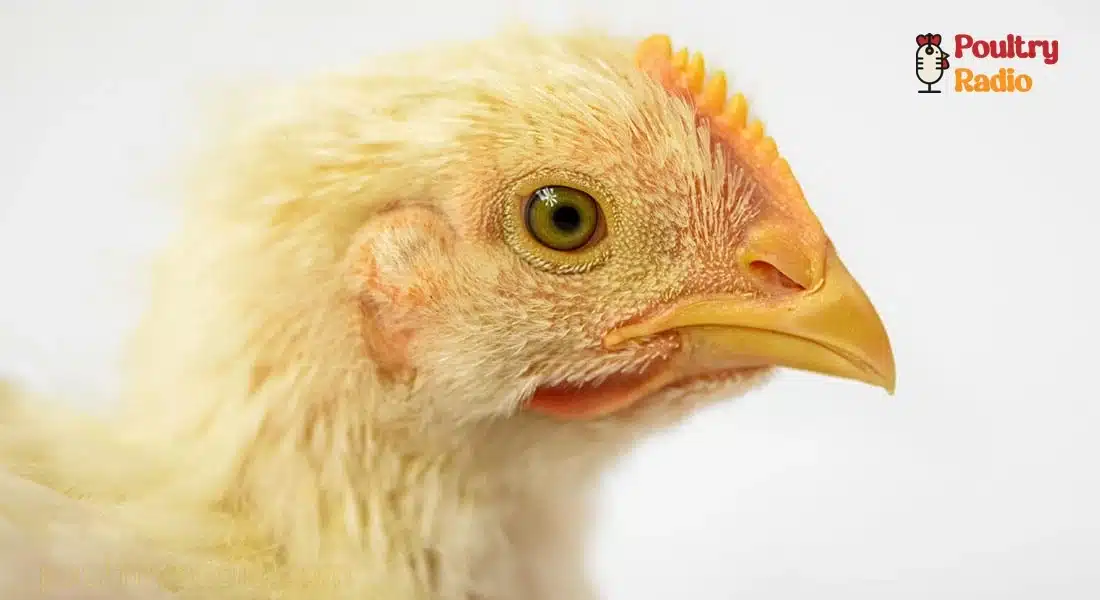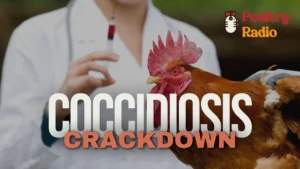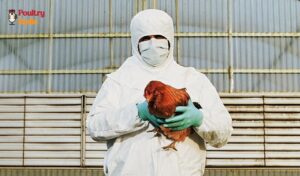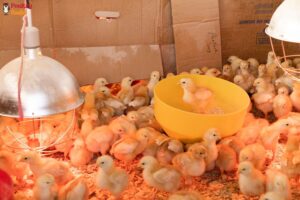Information About Infectious Bronchitis (IB)

What is Infectious Bronchitis in Chickens?
Infectious Bronchitis (IB) is a sudden, rapid, highly contagious viral respiratory disease of chicken. It is characterized by abnormal respiratory sounds, coughing, and sneezing. It is caused by a coronavirus called Infectious Bronchitis Virus (IBV)
As a result, Kidneys might be affected by the virus. Due to decreased egg production and poor eggshell quality in laying birds, the disease results in significant economic loss. Infection reduces feed efficiency and weight gain in both broilers and layers. All chicken species are susceptible; however, young chicks are the most frequently affected, with a high mortality rate.
The Infectious Bronchitis Virus (IBV) can easily spread by air and contaminated feces. Poor management practices, such as insufficient floor space, a dusty environment, and low humidity, make birds more susceptible to infectious bronchitis.
Etiology and Epidemiology of Infectious Bronchitis
Infectious bronchitis virus (IBV) is a type of avian gammacoronavirus that mainly affects chickens, although it has also been found in pheasants and peafowl, sometimes without causing obvious symptoms. This virus is found worldwide and the various antigenic types that can be present in the same area. Some types of IBV are widespread, while others are more limited to specific regions.
IBV can be spread by infected chickens through respiratory discharges and feces, and it can be transmitted through aerosol, ingestion of contaminated feed and water, as well as contact with contaminated equipment and clothing.
Chicken whether naturally infected or vaccinated with live IBV, may intermittently shed the virus for up to 20 weeks after infection. Typically, the virus has an average 24–48-hour incubation period, with the peak of respiratory tract virus excretion occurring 3-5 days post-infection.
The impact of the disease and the body systems affected can be influenced by:
- Virus type
- Chicken’s age, virus type, immune status, and diet
- Exposure to cold weather
- Furthermore, having a simultaneous infection with Mycoplasma gallisepticum, M synoviae, Escherichia coli, and/or Avibacterium paragallinarum can make the disease worse.
Pathogenesis of IBV
- Infectious bronchitis virus first infects and reproduces in the upper respiratory tract, leading to the loss of protective cells lining the sinuses and trachea. Following a brief viremia, the virus may be found in the kidneys and reproductive tract.
- Some types of IBV, known as nephropathogenic strains, can lead to kidney lesions. Kidney damage linked to various IB strains is becoming a more significant aspect of IB infections, particularly in broiler chickens.
Symptoms of Infectious Bronchitis in Chickens
- Coughing
- Sneezing
- Gasping
- Nasal and ocular discharge
- High morbidity rate
- High mortality in case of nephrogenic stain
- Reduced egg production (in some cases over 50%)
- Small, deformed, or shellless eggs
- Albumin loses its viscosity

Within 36 hours, clinical indications will appear in contact chicks, and within one to two days, they will appear in surrounding sheds. Coughing and rattling are frequent; they are worst in young chicks (broilers, for example) and spread quickly in confined or nearby hens. In flocks that are not vaccinated, morbidity is 100%. The virus strain determines the mortality rate, which can reach 60% in flocks that are not inoculated.

What are the Lesions of IB?
- Excess mucus in the respiratory tract
- A caseous plug may be found at the bifurcation of the trachea
- kidneys are swollen and pale
Diagnosis
Discovering an increase in antibody levels through ELISA or HI testing, as well as identifying and categorizing viruses using RT-PCR and sequencing methods.
Laboratory confirmation is necessary to diagnose respiratory forms of infectious bronchitis because they share similarities with mild forms of diseases caused by agents such as New Castle disease virus, Avian metapneumovirus, Infectious laryngotracheitis virus, Mycoplasmas, A paragallinarum, and Ornithobacterium rhinotracheale. Showing seroconversion or an increase in antibody titer against IBV by ELISA, hemagglutination inhibition, or virus neutralization tests can aid in diagnosis when there is a history of respiratory disease or reduced egg production.
Definitive diagnosis usually relies on detecting and identifying the virus. One method involves isolating the virus by introducing homogenized tracheal, cecal tonsil, and/or kidney tissue into 9- to 11-day-old SPF chicken embryos. If the infectious bronchitis virus (IBV) is present, signs include stunted and curled embryos along with urate deposition in the mesonephros, sometimes leading to mortality.
An alternative approach is to isolate IBV in tracheal organ cultures, where viral growth is indicated by the cessation of ciliary motility. For some field strains, multiple blind passages of the virus might be necessary for isolation. Reverse transcriptase PCR assays are commonly used to diagnose the virus, detecting viral RNA in nucleic acid extracts from tracheal, cecal tonsil, or kidney tissue.
Prevention and Control of IB disease
Vaccination:
A key method for stopping IB in chickens is vaccination. Depending on the particular virus variation that is prevalent in the area, different vaccination strains can be used.
The most widely used live vaccines globally are derived from the Massachusetts strain (Mass41, H120, and H52). Moreover, various IBV vaccine types are approved for use in different countries, along with live and killed autogenous vaccines specific for the variant virus in the region.
Biosecurity:
IB outbreaks can be stopped with the help of biosecurity measures such as isolating young birds, following stringent hygiene rules, and controlling access to poultry facilities.
Management:
IB in chickens can be prevented and controlled in a significant way by proper managemental practices. To prevent IB, keep the chicken connected at its ideal humidity level (60–70%) and stay away from dusty environments.
Bronchitis Infectious (IB) Treatment
There is no specific treatment for Infectious bronchitis. Use a bronchodilator to treat excess mucus in the trachea. For mixed infection use antibiotics against E.coli and mycoplasma. Use electrolytes in drinking water to support the kidneys.
In the case of baby chicks, it’s a good idea to increase the room temperature by 5°F until the symptoms are gone.
Key Points:
- Infectious Bronchitis is caused by a type of virus called avian coronavirus.
- The virus’s fast mutation rate means we need to keep a close watch to identify the types of IBV present in a certain area.
- Since different antigenic types don’t offer cross-protection, it’s really crucial to select the right vaccine(s) for protection.
Commonly Asked Questions
Can humans catch Bronchitis from chickens?
Typically, infectious bronchitis (IB) in chickens is not regarded as a zoonotic danger. There is no evidence that the particular Coronavirus strains that affect poultry can infect humans. However, because coronaviruses in general have been linked to zoonotic occurrences, conventional hygiene and biosecurity precautions should still be followed while handling affected birds to reduce any possible risks of disease transmission.
What is the causative agent of IB in poultry?
Infectious bronchitis (IB) is a viral disease in poultry caused by a coronavirus, which is a type of enveloped RNA virus. This coronavirus is part of the Coronaviridae family.
What is the vaccine for Infectious Bronchitis?
Nobilis® IB 4-91 is a live attenuated, freeze-dried vaccine that protects against Infectious Bronchitis virus serotype 4-91 or similar types. It’s suitable for 1-day-old chicks and older chickens, including broilers, breeders, and layers.
How do you diagnose Infectious Bronchitis in chickens?
Discovering an increase in antibody levels through ELISA or HI testing, as well as identifying and categorizing viruses using RT-PCR and sequencing methods.
How do you treat IB in poultry?
There is no specific treatment for Infectious bronchitis. Use a bronchodilator to treat excess mucus in the trachea. For mixed infection use antibiotics for 3-5 days to prevent secondary infection. Use electrolytes in drinking water to support the kidneys. In the case of baby chicks, it’s a good idea to increase the room temperature by 5°F until the symptoms are gone.
What is the pathogenesis of Infectious Bronchitis?
Infectious bronchitis virus first infects and reproduces in the upper respiratory tract, leading to the loss of protective cells lining the sinuses and trachea. Following a brief viremia, the virus may be found in the kidneys and reproductive tract.







